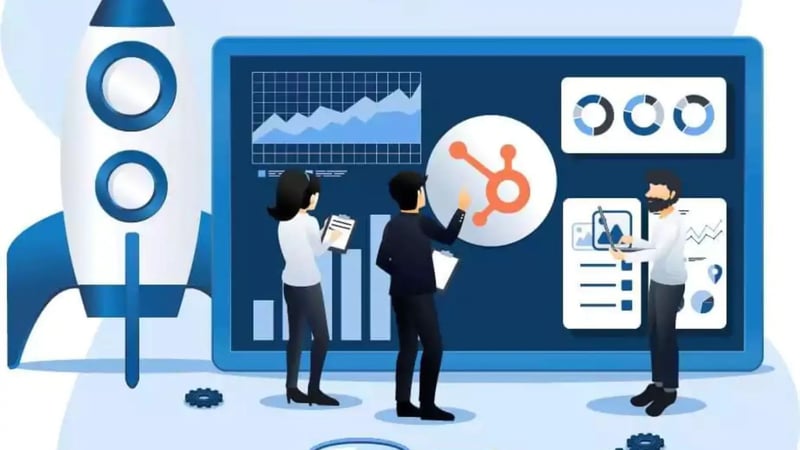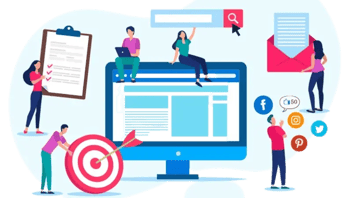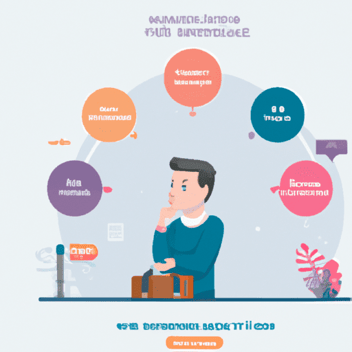SaaS Inbound Marketing: Strategies for Software as a Service Companies
In the competitive software-as-a-service (SaaS) market, traditional lead generation methods often fall short. Cold calls and intrusive advertising generate limited results, leaving businesses struggling to fill their pipelines with qualified leads.
The answer? Inbound marketing is a strategic approach that organically attracts ideal customers through valuable content and engaging experiences. Instead of chasing prospects, inbound marketing draws them in with relevant information and builds trust over time.
Understanding Your SaaS Audience
Success in the Software as a Service (SaaS) Industry hinges on a deep understanding of your audience. Crafting a compelling SaaS inbound marketing strategy begins with creating detailed buyer personas. These fictional representations encapsulate your target audience's key demographics, behaviors, and pain points, providing invaluable insights for personalized engagement.
Businesses prioritizing inbound marketing generate 54% more leads on average than those solely focused on outbound tactics.
Identify their pain points and needs to resonate with your SaaS audience effectively. Dive into customer feedback, conduct surveys, and analyze support queries to unearth their challenges. By empathizing with their struggles, SaaS companies can tailor their marketing content to offer solutions that genuinely address customer pain.
Here are some common pain points you may encounter:
-
Integration challenges
-
Complex onboarding processes
-
Security and compliance issues
-
Limited customization options
-
Inadequate customer support
-
Scalability concerns
-
Lack of training resources
By understanding these pain points, you can identify the solutions your customers need and want, tailoring your offerings and content accordingly. Speaking of content, tailoring content is crucial to the success of your inbound marketing strategy. As you delve into the intricacies of your audience's challenges, create content that educates, informs, and adds value at every stage of the buyer's journey. Whether they're navigating the awareness stage, considering options, or making a decision, your content should be strategically aligned to guide them seamlessly.
Consider developing content for inbound marketing that speaks directly to the challenges faced during the awareness stage. This might include blog posts, infographics, or educational videos that illuminate common issues within your industry. Focus on more in-depth content for the consideration stage, such as white papers, case studies, or comparison guides that showcase your SaaS solution's unique value propositions. Finally, during the decision stage, provide content reinforcing trust and highlighting the benefits and features that set your SaaS apart.
A crucial aspect of understanding your SaaS audience is continuously evolving buyer personas and content strategies. As industry trends and customer preferences shift, staying attuned to these changes ensures that your marketing efforts remain relevant and resonant.
Buyer Personas
Here's an example of a buyer persona you may craft for an ideal customer:Buyer Persona: Alex, the IT Decision Maker
Background: Alex is a 38-year-old IT Director working for a mid-sized e-commerce company. With over a decade of experience in the industry, Alex is responsible for making strategic technology decisions that align with the company's growth objectives.
Goals and Objectives:
- Ensure the seamless operation of the company's IT infrastructure.
- Implement technology solutions that enhance efficiency and productivity.
- Stay updated on emerging technologies to maintain a competitive edge.
Pain points:
- Struggling with outdated legacy systems that hinder scalability.
- Limited resources for comprehensive staff training on new technologies.
- Balancing the need for innovation with the necessity of maintaining stable IT operations.
Information Sources:
- Industry blogs and publications.
- Professional networking events and conferences.
- Online forums and communities for IT professionals.
To effectively engage Alex, the IT Decision Maker, your content strategy should revolve around delivering valuable insights and solutions that align with his goals and challenges. Here's how you can tailor content to address Alex's needs:
-
White paper: "Navigating Seamless Scalability in E-commerce IT"
-
-
Detail the challenges e-commerce companies face with scalability.
-
Showcase how your SaaS solution enables effortless scalability without disrupting operations.
-
Highlight real-world examples of companies similar to Alex's that have successfully scaled using your solution.
-
-
Case Study: "Revolutionizing IT Efficiency with Comprehensive Training"
-
-
Illustrate the impact of thorough training on IT efficiency.
-
Feature a case study of a company that faced similar resource constraints and overcame them with your comprehensive training resources.
- Emphasize how your solution empowers IT teams to adapt and leverage the full capabilities of the software quickly.
-
-
Security and Compliance Guide: "Securing E-commerce Operations in a Regulatory Landscape"
-
-
Address Alex's concerns about security and compliance.
-
Provide an in-depth guide on the security features embedded in your SaaS solution.
-
Offer insights into how your solution ensures compliance with industry regulations, showcasing our commitment to data protection.
-
-
Personalized Email Campaign:
-
-
Send personalized emails to Alex with links to the whitepaper, case study, and security guide.
-
Highlight the direct relevance of the content to his role and challenges.
-
Encourage engagement through a call-to-action, inviting him to explore how your SaaS solution aligns with his company's objectives.
-
-
Webinar: "Strategies for Future-Proofing Your IT Infrastructure"
-
-
Host a webinar featuring industry experts discussing IT trends and strategies.
-
Invite Alex to participate, providing an opportunity for direct interaction and addressing any specific questions or concerns he may have.
-
Showcase your SaaS solution's scalability, training, and security aspects during the webinar.
-
By aligning your content strategy with Alex's characteristics and needs, you create a compelling narrative that resonates with him personally and professionally. This tailored approach enhances the likelihood of capturing his attention, building trust, and ultimately influencing the decision-making process in favor of your SaaS solution.
Building a SaaS Content Strategy
Crafting a content strategy tailored to the unique needs of your SaaS audience is essential for attracting, engaging, and converting potential users throughout their buyer's journey.
Keyword Research
-
Long-tail keywords: Long-tail keywords play a pivotal role in SaaS content strategy, capturing specific user intent and enhancing the visibility of your content in search engine results. For instance, rather than targeting a generic term like "project management software," consider long-tail variations like "cloud-based project management software for small teams." This narrows the competition and attracts users with a more evident purchasing intent.
-
Competitor analysis: Conducting a thorough analysis of competitors within the SaaS space provides valuable insights into the keywords driving their success. Identify high-performing keywords that align with your SaaS offering and incorporate them strategically into your content. This boosts your search engine ranking and ensures your content resonates with the language your target audience uses.
Content Mapping
-
Awareness stage: At the awareness stage, potential users identify challenges and seek solutions. Develop blog posts, infographics, and introductory videos that address common pain points within your SaaS niche. For example, a blog post titled "5 Signs Your Business Needs Cloud-Based Collaboration Tools" can capture the attention of those exploring solutions for team collaboration issues.
-
Consideration stage: As users delve deeper into their research, they seek comparative insights and in-depth information. In the consideration stage, create content such as whitepapers, case studies, and feature comparison guides to help users evaluate your SaaS solution against competitors. A case study titled "How Company X Boosted Productivity by 30% with Our Project Management Software" provides tangible evidence of your solution's efficacy.
-
Decision stage: At the decision stage, users are ready to commit. Offer content that instills confidence in your SaaS solution, such as product demos, free trials, and customer testimonials. Craft a demo video showcasing your project management software's intuitive interface and time-saving features, emphasizing the tangible benefits users will experience.
Email Marketing
-
Targeted email list: Use lead magnets and opt-in strategies to attract engaged prospects. Ensure your email list is segmented for personalized communication based on user behavior and preferences.
-
Compelling email campaigns: Tailor content to align with the buyer's journey, starting with educational content in the awareness stage and transitioning to product-focused messaging in the consideration and decision stages. Implement persuasive calls-to-action strategically, guiding leads toward conversion.
-
Drip campaigns: Keep your audience engaged over time with comprehensive drip campaigns. Share product updates, exclusive offers, and valuable insights through strategically timed emails.
On-Page SEO
-
SEO-friendly URLs: Optimize your URLs by incorporating relevant keywords and maintaining a clear, readable structure. For example, a blog post addressing the benefits of your SaaS CRM solution could have a URL like "/saas-crm-benefits."
-
Meta titles and descriptions: Craft meta titles and descriptions that include target keywords and entice users to click. An engaging meta description for a blog post on "Streamlining Workflows with Our Cloud-Based Project Management Software" can significantly impact click-through rates.
-
Strategic keyword placement: Integrate target keywords strategically within your content, ensuring a natural and reader-friendly flow. Use header tags (H1, H2, H3) to structure your content, emphasizing the importance of key phrases.
Technical SEO
-
Mobile responsiveness: With increasing numbers of users accessing content via mobile devices, ensuring your SaaS website is mobile-responsive is non-negotiable. Google prioritizes mobile-friendly websites, impacting both search rankings and user experience.
-
Fast loading times: Users today expect instant access to information. Optimize your SaaS website's loading times by compressing images, leveraging browser caching, and utilizing Content Delivery Networks (CDNs). A swift website satisfies users and positively influences search rankings.
-
Secure website (HTTPS): Security is paramount in the digital age. Transitioning to HTTPS encrypts data exchanged between users and your website and is also a ranking factor considered by search engines. This small but impactful step enhances both user trust and SEO performance.
Building a solid SaaS content strategy requires a nuanced understanding of your target audience, the competitive landscape, and the intricacies of SEO. By strategically incorporating long-tail keywords, mapping content to the buyer's journey, optimizing for search engines, and ensuring technical SEO excellence, your SaaS company can establish a compelling online presence that resonates with potential users and drives sustainable growth. Remember, in the world of SaaS, a well-crafted content strategy isn't just a component; it's a cornerstone for success.
Measure and Analyze SaaS Inbound Marketing Success
When it comes to any inbound marketing strategy, measuring and analyzing campaign performance is critical for refining strategies and maximizing ROI. The first step is establishing key performance indicators (KPIs) tailored to you the objectives of your SaaS campaign.
Setting Key Performance Indicators (KPIs)
-
Define measurable goals for lead generation, conversion rates, and customer acquisition cost.
-
Establish KPIs that align with different stages of the buyer's journey, from awareness to conversion, providing a holistic view of your marketing funnel.
Use Analytics Tools
-
Google Analytics: Leverage this powerful tool to gain insights into website traffic, user behavior, and conversion paths. Track the performance of specific landing pages, blog posts, and conversion forms.
-
Marketing Automation Platforms: Implement robust marketing automation platforms (like HubSpot) to track the entire customer journey. Monitor email engagement, lead nurturing, and conversion rates to understand how leads progress through the marketing funnel.
A/B Testing for Optimization
-
Implement A/B testing on various elements, including email subject lines, call-to-action (CTA) buttons, and landing page layouts.
-
Analyze the results to identify what resonates best with your audience, informing future campaign optimizations.
Social Media Engagement
-
Monitor social media metrics like likes, shares, and comments to gauge audience engagement.
-
Identify the most effective channels and content types to tailor your social media strategy accordingly.
Customer Feedback
-
Collect feedback directly from customers through surveys or feedback forms.
-
Use this qualitative data to understand customer satisfaction, identify pain points, and refine your SaaS offering and marketing approach.
Continuous Improvement
-
Regularly review and analyze performance to identify trends and areas for improvement.
-
Stay agile and adapt strategies based on the evolving landscape, emerging trends, and shifts in customer behavior.
Measuring and analyzing SaaS Inbound Marketing success goes beyond tracking metrics; it involves extracting actionable insights that inform strategic decisions. SaaS companies can refine their marketing approach by setting meaningful KPIs, using analytics tools, continuously improving strategies, and ensuring sustained growth in a competitive landscape.
Inbound Marketing for Sustainable SaaS Growth
In the dynamic SaaS landscape, attracting and retaining qualified leads demands a strategic approach. Traditional methods often fall short, leaving businesses with limited results and dwindling pipelines. However, inbound marketing emerges as a potent solution, attracting ideal customers organically through valuable content and engaging experiences.
Implementing inbound marketing is an ongoing process, not a quick fix. By continually adapting and improving based on data and customer feedback, you can cultivate a sustainable growth engine for your SaaS business. Embrace the human connection, offer genuine value, and watch your business flourish as you attract and retain customers who resonate with your brand.
This content is also available in:
- German: SaaS Inbound Marketing: Strategien für SaaS-Firmen
- Spanish: Inbound Marketing SaaS: Estrategias para SaaS
- French: Inbound Marketing SaaS: Stratégies pour entreprises SaaS
- Italian: Inbound Marketing SaaS: Strategie per aziende SaaS
- Romanian: Inbound Marketing SaaS: Strategii pentru firme SaaS
- Chinese: SaaS 入站营销:软件即服务公司的策略











Leave a Comment